
Phoebus is an incorporated town located in present day Hampton, Virginia on the Virginia Peninsula. In 1900, it was named in honor of local businessman Harrison Phoebus (1840–1886), who is credited with convincing the Chesapeake and Ohio Railway (C&O) to extend its tracks to the town from Newport News.

The Capitol Limited was an American passenger train run by the Baltimore and Ohio Railroad, originally between New York City and Grand Central Station in Chicago, Illinois, via Union Station, Washington, D.C., Baltimore and Pittsburgh. For almost 48 years, it was the B&O's flagship passenger train, noted for personalized service and innovation. At the time of its discontinuation on May 1, 1971, when Amtrak took over most rail passenger service in the U.S., the Capitol Limited operated between Washington and Chicago.

The Cincinnatian was a named passenger train operated by the Baltimore and Ohio Railroad (B&O). The B&O inaugurated service on January 19, 1947, with service between Baltimore, Maryland and Cincinnati, Ohio, carrying the number 75 westbound and 76 eastbound, essentially a truncated route of the National Limited which operated between Jersey City, New Jersey and St. Louis.

The George Washington was a named passenger train of the Chesapeake and Ohio Railway running between Cincinnati, Ohio and Washington, D.C. A section divided from the main train at Gordonsville, Virginia and operated through Richmond to Phoebus, Virginia. From the west, a section originated in Louisville and joined at Ashland. The train began service in 1932 to mark the 200th anniversary of the birth of the first president of the United States.

Martin Luther King Jr. Plaza is the main passenger rail and intercity bus station of Toledo, Ohio.
Northern Arrow was one of the named passenger trains of the Pennsylvania Railroad, starting at Cincinnati, Ohio and ending at Mackinaw City, Michigan. It had merging branches originating from Chicago, Illinois, converging in Fort Wayne, Indiana, and a train from St. Louis, Missouri from the west, converging at Richmond, Indiana. Carrying the number #519 northbound and #520 southbound, it used the Grand Rapids and Indiana Railroad, a leased subsidiary of the Pennsylvania system.

Ashland Transportation Center is an intermodal transit station in Ashland, Kentucky. Jointly operated by the City of Ashland and CSX Transportation, it currently serves Amtrak's Cardinal train as well as the Ashland Bus System and Greyhound Lines buses. It is located at 99 15th Street near downtown Ashland.

Newport News station is an Amtrak intercity train station in Newport News, Virginia. The station is the southern terminus of two daily Northeast Regional round trips. It has a single side platform adjacent to a large CSX rail yard. An Amtrak Thruway motorcoach connection to Norfolk station effectively doubles the frequency between each station and Washington.
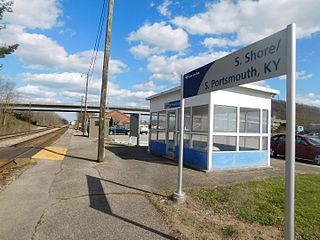
South Portsmouth–South Shore station is an Amtrak intercity rail station in South Shore, Kentucky. It primarily serves the city of Portsmouth, Ohio, located across the Ohio River.
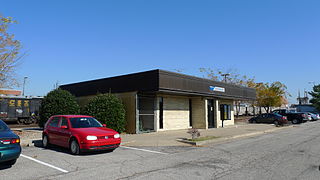
Huntington station is an Amtrak station in Huntington, West Virginia. Located at 1050 8th Avenue, the station consists of a platform on the south side of the east-west tracks, a small parking lot, and a small building in between. The station contains a waiting room and space for a ticket office, though Amtrak pulled the station agent in the 21st century. Huntington is served by the Cardinal route. The Amtrak station replaced a Chesapeake and Ohio station on 7th Avenue. The C&O station hosted daily trains headed northwest, west and east: Fast Flying Virginian, George Washington and the Sportsman.
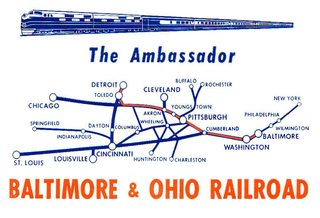
The Ambassador was a named train of the Baltimore and Ohio Railroad (B&O) on its route between Baltimore, Maryland and Detroit, Michigan with major station stops in Washington, D.C., and Pittsburgh, Pennsylvania, and Toledo, Ohio. Inaugurated in 1930, the Ambassador was discontinued in 1964.
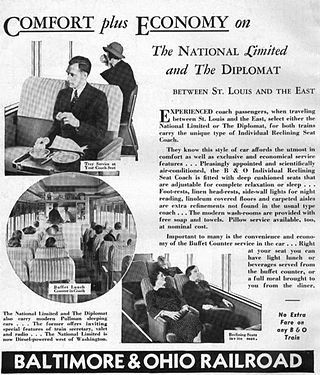
The Diplomat was a named passenger train of the Baltimore and Ohio Railroad (B&O) during the 1930s–1950s connecting New York City and St. Louis, Missouri, via Washington, D.C. Other B&O trains on the route during that period were the premier National Limited and the workhorse Metropolitan Special. The train was inaugurated in August 1930 after several changes to trains along the St. Louis Route. After World War II, the Diplomat operated as Train No. 3 westbound, and No. 4 eastbound. It was timed to provide connections to several western railroads that terminated in St. Louis, including the Frisco, the Santa Fe, Cotton Belt and Missouri Pacific, among others.

The Washington–Chicago Express, an American named passenger train of the Baltimore and Ohio Railroad (B&O), was one of four daily B&O trains operating between Washington, D.C., and Chicago, Illinois, via Pittsburgh, Pennsylvania during the 1930s–1960s. Other B&O trains of that period on the route were the Capitol Limited, Columbian, and the Shenandoah.
The Night Express was an American named train of the Baltimore and Ohio Railroad (B&O) on its route between Detroit, Michigan, and Louisville, Kentucky, with major station stops in Toledo, Ohio, and Cincinnati. The service was numbered Train 57 southbound and Train 58 northbound. The numbers 57/58 operated on the Detroit - Cincinnati line as early as 1921. The service was provided in conjunction with the Pere Marquette Railroad from Detroit to Toledo and with the Louisville and Nashville from Cincinnati to Louisville with connections to New Orleans.

The James Whitcomb Riley was a passenger train that operated between Chicago, Illinois, and Cincinnati, Ohio, via Indianapolis, Indiana. Originally operated by the New York Central Railroad, it was taken over by Amtrak in 1971. Under Amtrak, it merged with the Chesapeake & Ohio Railway's George Washington to become a Chicago-Washington/Newport News train. In 1977, it was renamed the Cardinal, which remains in operation.
The Fast Flying Virginian (FFV) was a named passenger train of the Chesapeake & Ohio Railway.

The Mountaineer was a passenger train operated by Amtrak between Norfolk, Virginia, and Chicago, Illinois, via Cincinnati, Ohio. It was the first train to use the Norfolk and Western Railway's tracks since the creation of Amtrak in 1971 and followed the route of the Pocahontas, the N&W's last passenger train. Service began in 1975 and ended in 1977. A new train, the Hilltopper, operated over much of the Mountaineer's route but was itself discontinued in 1979.
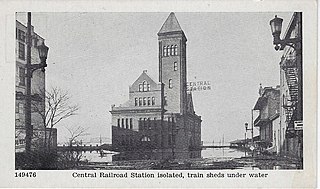
Central Station was a major train station in Louisville, Kentucky. Built in the Richardsonian Romanesque style, it served several railroad companies until the mid-20th century. It was situated at North 7th Street and West River Road, near the Ohio River waterfront, and it was also known as the 7th Street Depot.
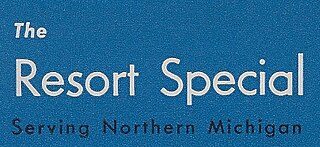
The Resort Special was a seasonal night train from Chicago, renowned for serving resort towns such as Traverse City, Charlevoix, Petoskey on the northwestern part of Michigan’s lower peninsula. Begun by the Pere Marquette Railway, it was a rare instance of a named Pere Marquette train continuing after the Chesapeake & Ohio absorbed the Pere Marquette Railway in 1947. In 1960s, the C&O shifted the Resort Special name to a White Sulphur Springs, West Virginia to New York City route.
Lexington Union Station was a union station, serving most of the railroads passing through Lexington, Kentucky. Located on Main Street, just west of Walnut Street it served the Chesapeake and Ohio Railway and the Louisville and Nashville Railroad from 1907 to 1957.

















